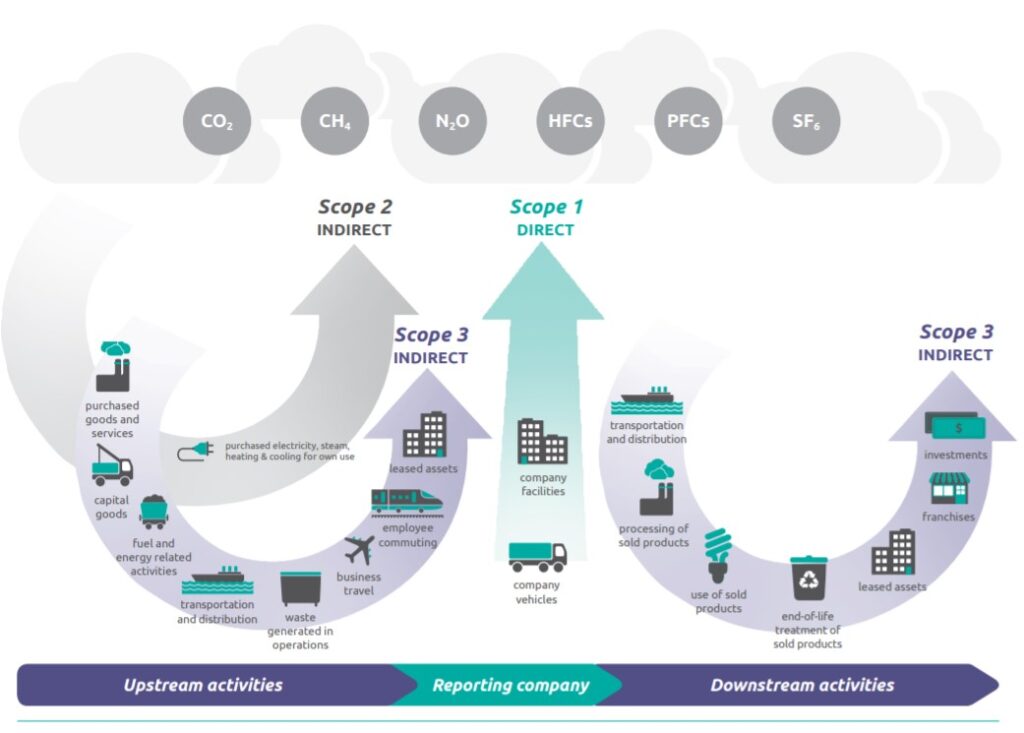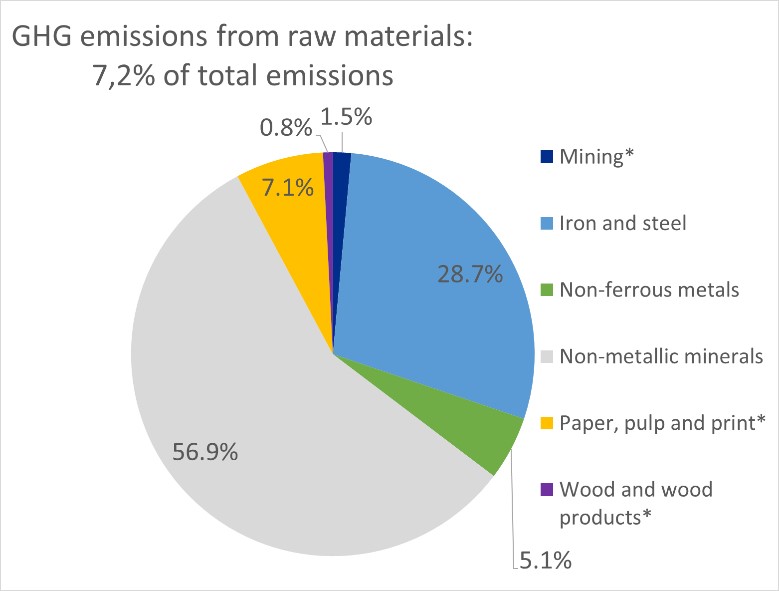How to Reduce Scope 3 Emissions: What Scope 3 Emissions Are and How Companies Can Address Them
This guide was developed to help provide an overview of Scope 3 emissions. We provide context and background information to help you understand what Scope 3 emissions are, why they must be reduced, and what responsibilities businesses hold when it comes to measuring, reporting and reducing Scope 3 emissions. This comprehensive guide focuses on how to reduce Scope 3 emissions and provides tools to do so.
See the table of contents below for quick navigation.
Summary of Key Points
- Scope 3 emissions are all indirect emissions that occur in a company’s value chain. Scope 3 emissions include activities that contribute to the creation of a product, both upstream and downstream, that are not performed by the reporting company itself.
- Companies can benefit from reducing their Scope 3 emissions
- Companies can reduce their Scope 3 emissions by choosing which materials or vendors they rely on, making informed transportation decisions, or encouraging their suppliers to reduce their own emissions.
- The steps to reduce Scope 3 emissions vary based on where in the value chain the emissions are produced.
- While Scope 3 emissions reporting is generally lagging among the world’s worst polluting companies, some major companies are taking action to reduce their Scope 3 emissions.
Table of Contents
Why Do Scope 3 Emissions Need to Be Reduced?
How Does Measuring Scope 3 Emissions Benefit a Company?
How to Reduce Scope 3 Emissions
The State of Scope 3 Emission Reductions Today
Case Studies: Scope 3 Emission Reductions in Action
What Are Scope 3 Emissions?
The Greenhouse Gas (GHG) Protocol is a partnership of businesses, NGOs, and governments that aims to create GHG reporting standards in order to reduce carbon emissions. The GHG Protocol categorizes emissions into three groups or ‘scopes’ for accounting and reporting purposes.
- Scope 1 emissions are direct emissions from the company in question (the “reporting company”).
- Scope 2 emissions are indirect emissions from energy consumed by the reporting company.
- Scope 3 emissions include all other indirect emissions that occur in a company’s value chain. In other words, Scope 3 emissions are emissions that occur in every step of the process that gets a product (a value) to customers (including production, marketing, transportation, etc.).
Any emissions created by other companies in the process are included if the reporting company depends on those actions to produce or sell their product. Thus, the Scope 3 emissions for one organization are typically the Scope 1 and 2 emissions of another organization.
Learn more about value chains.
The overall goal of this categorization is to increase business’ reporting of GHG emissions in order to reduce them. Six greenhouse gases, covered by the Kyoto Protocol, are included in these scopes:
- Carbon dioxide (CO2)
- Methane (CH4)
- Nitrous oxide (N2O)
- Hydrofluorocarbons (HFCs)
- Perfluorocarbons (PFCs)
- Sulfur hexafluoride (SF6)
Scope 3 emissions include all indirect emissions produced both upstream and downstream of a company in a supply chain.
- Upstream emissions include any emissions from materials or services that flow into the reporting company from suppliers.
- Downstream emissions include emissions from any activities that get the product to the customer (that occur after the reporting company has produced their service or product), or that occur as a result of the product’s use.
Scope 3 emissions can be split into 15 smaller categories, listed below. Categories 1-8 are considered upstream emissions, while categories 9-15 are considered downstream categories.
Descriptions for each Scope 3 category begin on page 7 of the GHG Protocol’s Technical Guidance for Calculating Scope 3 Emissions.
| Scope 1 | Scope 2 | Scope 3 |
| Company transportation (eg. company vehicles, fuel) Company facilities | Purchased energy: electricity, heat, and steam | Category 1: Purchased goods and services Category 2: Capital goods Category 3: Fuel and energy-related activities Category 4: Upstream transportation & distribution Category 5: Waste generated in operations Category 6: Business travel Category 7: Employee commuting Category 8: Upstream leased assets Category 9: Downstream transportation and distribution Category 10: Processing of sold products Category 11: Use of sold products Category 12: End-of-life treatment of sold products Category 13: Downstream leased assets Category 14: Franchises Category 15: Investments |
Why Do Scope 3 Emissions Need to Be Reduced?
Reducing Scope 3 emissions is one of the best ways to reduce GHG emissions globally, thereby slowing or reversing climate change. Scope 3 emissions often make up the majority of a company’s emissions; Scope 3 emissions are a good place to focus, as reduction will have a large impact.
Business for Social Responsibility (BSR) notes in a 2020 report that companies have so far focused on measuring and reducing their Scope 1 and Scope 2 emissions, yet the greatest emission reduction opportunities lie in Scope 3 emissions, which are approximately 5.5 greater than Scope 1 and Scope 2 emissions combined (BSR 2020).
Over 50% of the world’s carbon emissions come from only eight supply chains: food, construction, fashion, fast-moving consumer goods, electronics, automotive, professional services, and freight (World Economic Forum 2021). Measuring and managing Scope 3 emissions from these few industries would have a significant impact on reversing climate change.
Scope 3 Reduction Targets
In order to achieve only 1.75°C total warming by 2100, an ambitious climate change reduction goal, global upstream Scope 3 emissions would need to be reduced by an additional 54% compared to a baseline scenario (Li et al. 2019). Without this reduction, we are currently on track for a warming between 2.1 and 3.9°C (Climate Action Tracker).
This scenario is possible through a 58–67% reduction in energy, transport, and materials, 50-52% reduction in manufacturing, services, and buildings, and 39% reduction in agriculture, forestry, and other land use (Li et al. 2019).
How Does Measuring Scope 3 Emissions Benefit a Company?
Measuring Scope 3 emissions is not required, and use of the Scope 3 Standard is voluntary. However, in order to comply with the (voluntary) GHG Protocol Corporate Value Chain
(Scope 3) Accounting and Reporting Standard, companies must measure Scope 1, 2 and 3 emissions.
Additionally, in the future the standards may become mandatory if governments or certification programs adopt them.
Just because there are no reporting requirements doesn’t mean companies shouldn’t work to reduce their Scope 3 emissions. Because Scope 3 emissions often make up the majority of a company’s emissions, many companies are realizing the opportunity that Scope 3 emissions present to reduce GHG emissions. Reducing your company’s Scope 3 emissions poses several benefits.
Benefits of Reporting and Reducing Scope 3 Emissions
The most obvious benefit of reducing Scope 3 emissions is the reduction of climate change. However, reducing Scope 3 emissions can benefit individual companies as well.
Better Performing Stock: Research shows that company stocks with low Scope 3 emissions will perform better. A 2015 study found that investment portfolios of low-carbon intensity stocks significantly outperform portfolios of high-carbon intensity stocks. Stocks of companies with low Scope 3 emissions outperform high-carbon intensity stocks at even greater levels (Harris 2015).
Reduced Costs & Energy Use: While Scope 3 emissions does not include energy used by the reporting company directly, it does include energy use in their supply chain. By identifying high-energy users in the supply chain, the company can increase efficient energy use in their supply chain and reduce their own Scope 3 emissions, which can help lower costs.
Products with Increased Energy Efficiency: When companies reduce their Scope 3 emissions by creating more energy efficient products, customers may be more likely to buy their products. Increasingly, consumers care about the energy efficiency of their products, because this reduces both energy bills and climate change). According to a 2021 poll, 4 in 5 customers consider energy efficiency when buying items like home appliances (Morning Consult 2021).
The GHG Protocol’s Scope 3 Standards also help companies to:
- “Identify and understand risks and opportunities associated with value chain emissions
- Identify GHG reduction opportunities, set reduction targets and track performance
- Engage suppliers and other value chain partners in GHG management and sustainability
- Enhance stakeholder information and corporate reputation through public reporting” (GHG Protocol).
How to Reduce Scope 3 Emissions
Because Scope 3 emissions are indirect, the reporting company’s ability to address these emissions is somewhat limited. This leaves many companies wondering how to reduce Scope 3 emissions. However, the company can address Scope 3 emissions in a variety of ways, such as choosing which materials or vendors they rely on, making informed transportation decisions, or encouraging their suppliers to reduce their own emissions.
There are several steps companies can take to reduce their Scope 3 emissions. Get the basics on how to reduce scope 3 emissions from this infographic, and then continue reading for more details.
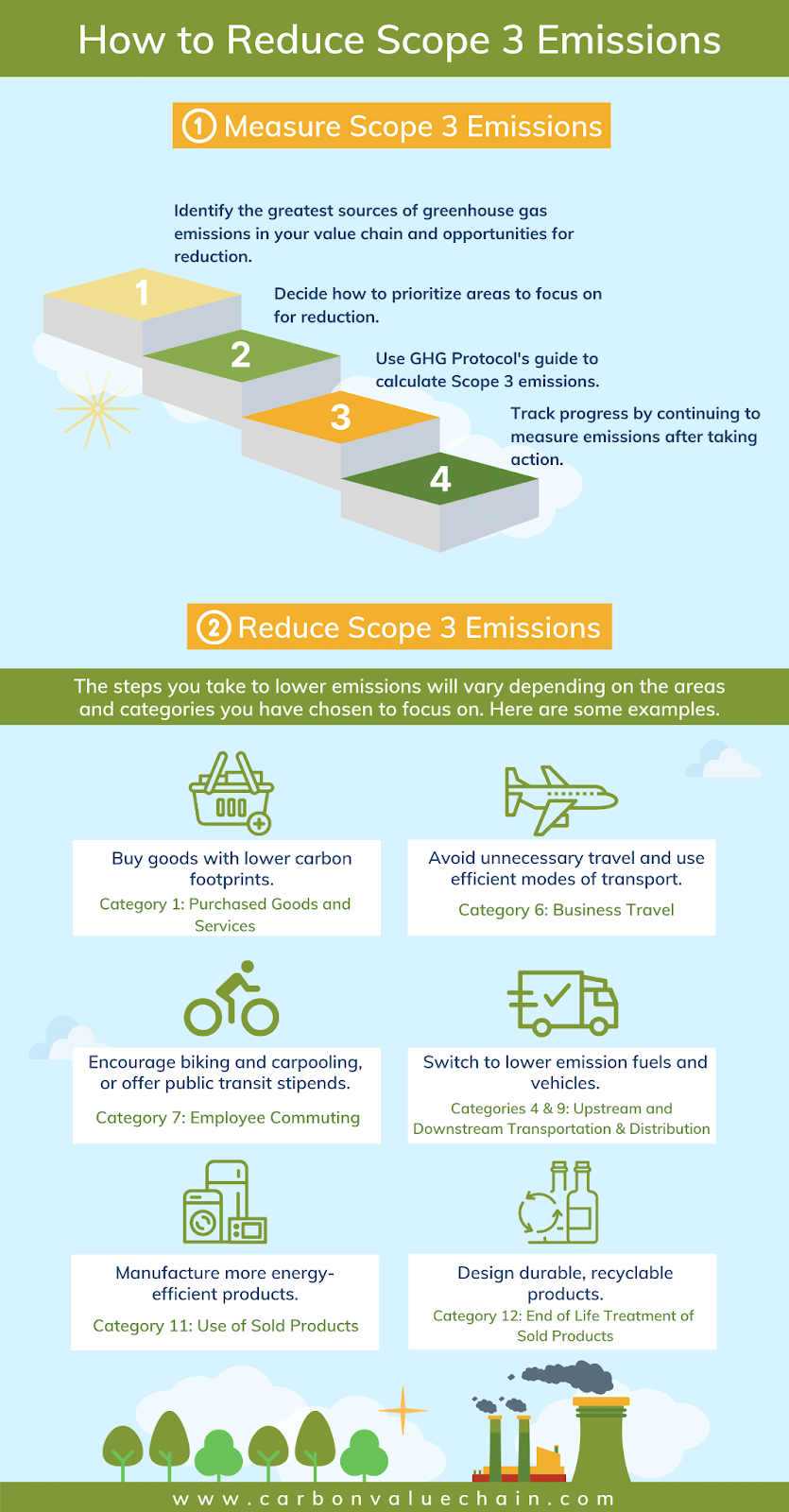
1. Measuring Scope 3 Emissions
The first and most important step in reducing Scope 3 emissions is knowing how much Scope 3 gases you’re emitting in the first place.
The purpose of the GHG Protocol’s Scope 3 Standards is to aid companies in measuring their emissions in a consistent, harmonized manner. Measuring emissions helps companies to better understand where in their value chains they’re emitting the most, and thus allows companies to address these ‘hot spots’ systematically and intentionally.
Doing the calculations yourself is possible. There is a different equation you can use for each category type.
First, companies should perform a broad overview of their value chain and identify the following for each of the 15 Scope 3 categories:
- The greatest sources of Scope 3 GHG emissions
- The greatest opportunities for GHG reduction
- The sources that are most relevant to the company’s business goals
Second, the company can take this generalized information and decide how to prioritize areas to focus on for reduction. Guidance on how to choose relevant Scope 3 activities can be found on page 11 of the GHG Protocol’s Technical Guidance for Calculating Scope 3 Emissions. This guidance also provides a description of the 15 category types and describes the necessary information needed for calculating emissions for each category.
Third, use the GHG Protocol’s guides for calculating Scope 3 emissions for each category type.
Additionally, the GHG Protocol has created a new Excel tool that helps companies measure their emissions in each of the 15 categories in a straightforward way.
Fourth, continue measuring emissions after taking reduction steps in order to empirically track progress.
2. Reduce Scope 3 Emissions
This goal is very broad, as the actual steps taken to reduce emissions will vary depending on the areas and categories the company has decided to focus on reducing. Here are some examples:
Category 1: Purchased Goods and Services. Reduce emissions in this category by purchasing goods with a lower carbon footprint, such as swapping raw materials or using recycled raw materials. You can also reduce emissions in this category by reducing the quantity of your purchases and reducing waste in the production process in order to use materials efficiently or reuse materials.
The chart below shows the breakdown of greenhouse gas emissions by material type. While large changes to material type may not be possible, even small changes, such as switching one type of oil for another, can have large impacts.
Category 6: Business Travel. Reduce emissions in this category by assessing travel routes and travel methods. For example, whenever possible, opt for shorter travel routes and less carbon intensive modes of transport. Consider whether travel is necessary in the first place, and if it’s possible to conduct the same business online. You can also consider buying carbon offsets to offset the carbon emitted from plane or other travel.
Category 7: Employee Commuting. Encourage your employees to adopt less carbon-intensive methods of commuting. This can include educational programs on options besides cars, “green” programs that encourage biking, or the creation of a carpooling program through the company. Many companies offer a public transportation stipend to encourage employees to use other, more “green” options like trains and buses. Some companies also provide a shower to encourage employees to bike to the office.

Categories 4 and 9: Upstream and Downstream Transportation & Distribution. While it may be difficult to influence the type of vehicle suppliers or distributors use, companies can still reduce transportation emissions (and costs) by reducing the distance that must be traveled, shipping larger quantities at once to create fewer trips, and shipping lighter-weight products.
When possible, consider switching fuels or using a vehicle type with low emissions. Companies can take a leap towards sustainability by considering the use of low to zero-emission vehicles, such as electric vehicles (EVs). Embracing EVs can bring multiple benefits, not only by reducing carbon emissions but also through cost-saving opportunities. In certain regions like California, the Low Carbon Fuel Standard program (LCFS) offers an excellent example of incentivizing eco-conscious choices. Under this program, EV fleet owners have the opportunity to earn energy rebates for each metric ton of carbon emissions avoided by utilizing zero-emission vehicles. Such rebates not only contribute to companies’ environmental goals but also provide financial advantages, making the transition to low-emission transportation all the more attractive.
This calculator helps compare the carbon emissions for shipping cargo on different types of vehicles, such as by train or by ship. Simply input the weight of your cargo and your points of origin and destination, and pick a transportation type.
Category 11: Use of Sold Products. Some consumer products emit GHGs during their intended use by customers. Reducing the amount of energy these products, such as electrical appliances, consume to function will reduce the emissions that result from use.
Category 12: End Of Life Treatment Of Sold Products. Reduce emissions in this category by designing your products with the end of their life in mind. For example, design products that can be recycled, which produces fewer emissions than landfill or incineration. You may also consider increasing the lifetime of your products’ use in order to reduce the amount that must be produced (and that must then be disposed of).
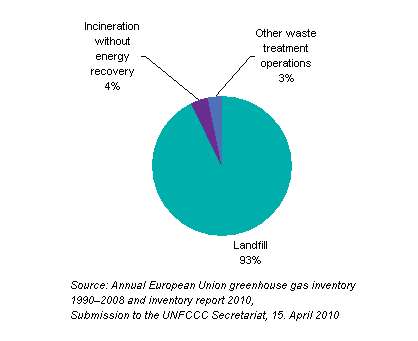
Source: EU Eurostat
Increased recycling of waste used in production also has a large effect. A 2009 EPA report found that doubling the recycling of construction and demolition debris would result in 150 million metric tons of carbon dioxide less being emitted per year.
3. Work Collectively
Calculating and reducing Scope 3 emissions can be hard due to difficulties obtaining the necessary data and high demand for collaboration with suppliers. Because Scope 3 emissions include the actions of other companies by definition, collective action at the industry level may be necessary.
For example, industry collaboration to reduce Scope 3 emissions allows the industry to set energy efficiency standards for suppliers, rather than an individual company setting a standard for the supplier that only applies when working with that company.
Emissions and reporting standards and communication throughout the supply chain will help reduce Scope 3 emissions. Increased supply chain visibility and trust is a promising path forward for reducing Scope 3 emissions as efficiently and effectively as possible (Royo 2020).

The State of Scope 3 Emission Reductions Today
The reporting of Scope 3 emissions is still lagging. For example, among the ~2,900 constituent companies across 11 sectors in the MSCI ACWI Index (which is designed to represent performance of the full opportunity set of large- and mid-cap stocks across 23 developed and 25 emerging markets), only 18% of them reported Scope 3 emissions, and there was great variability across sectors (Baker 2020).
Recent reporting also indicates that among the world’s worst polluters, especially those dealing in fossil fuels both in the private and public sectors, Scope 3 emissions reporting is either minimal or nonexistent (Fickling & He 2020).
There is also some concern that the industry standard itself (the GHG Protocol Corporate Standards) allows such a high degree of discretion that whatever reporting occurs may be inconsistent and may not properly capture the situation (Fickling & He 2020).
For example, companies with similar Scope 3 emissions in reality are interpreting the standards differently, and are thus reporting vastly different numbers of emissions. This results in an inaccurate portrayal of how many metric tons of greenhouse gases are actually being emitted.
Read the full investigation on inaccurate Scope 3 emissions reporting by polluters here.
Solutions to increase Scope 3 emissions reporting and reduction may include:
- Refining the GHG standards to clarify reporting best practices and requirements
- Creating and enforcing Scope 3 reporting requirements
- Implementing incentives for Scope 3 emissions reduction similar to carbon taxes
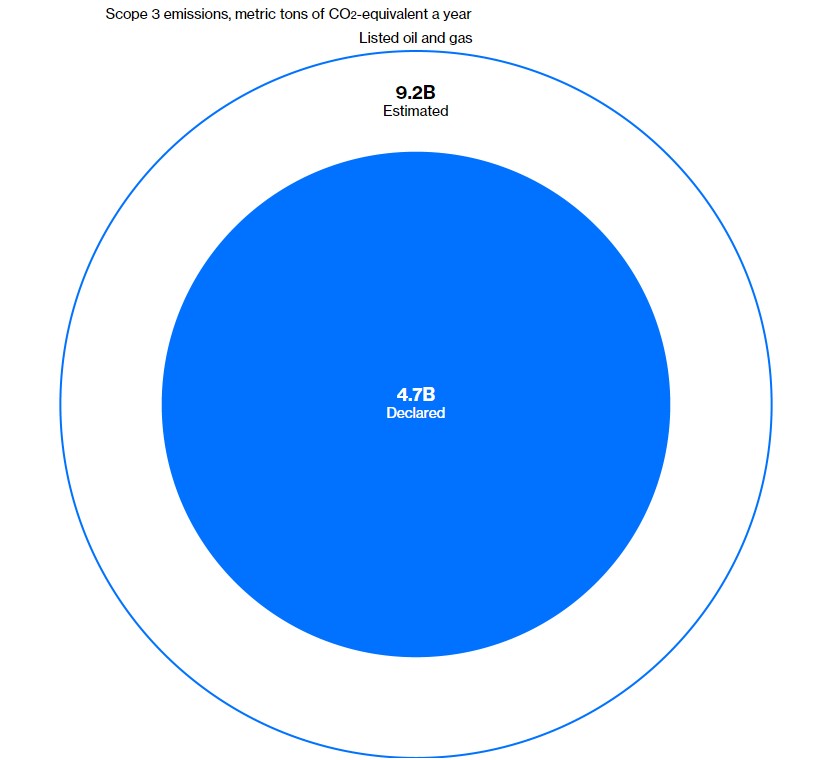
Source: Fickling & He 2020
Case Studies: Scope 3 Emission Reductions in Action
Despite an overall lack of Scope 3 emission reporting, some major companies are working to report and reduce their Scope 3 emissions.
For example, Tesco, one of the world’s largest retailers, is working to become carbon neutral by 2050. After analyzing what it will take to reach this goal, Tesco pledged to reduce its Scope 3 GHG emissions by 17% by 2030.
Tesco is reducing their carbon emissions through increased energy efficiency, reduced waste, and other initiatives. Read more about Tesco’s carbon-reduction plan.
A large number of companies have also “road-tested” the GHG Protocol’s Scope 3 Standards to calculate their Scope 3 emissions. These companies include Ocean Spray, 3M, Kraft Foods, Lenovo, and Shell, among others.
However, as noted above, the standards for Scope 3 emissions calculation and reporting may need to be clarified to truly work most effectively.
Resources for Companies: How to Reduce Scope 3 Emissions
Resources on Scope 3 emissions from the GHG Protocol include:
- Technical Guidance for Calculating Scope 3 Emissions – This PDF provides guidance on how to choose relevant Scope 3 activities, provides a description of the 15 category types and describes the necessary information needed for calculating emissions for each category.
- Scope 3 Evaluator Tool – This tool helps companies calculate their Scope 3 emissions.
Other calculation resources:
- Greenhouse Gas Inventory Guidance Indirect Emissions from Events and Conferences – This PDF from the EPA helps companies calculate the Scope 3 emissions produced from events such as concerts and conferences, such as meetings or conventions. The emissions sources covered include: travel to and from an event, emissions from hotel stays by attendees, and emissions from the event or conference venue.
- Scope 3 Emissions: Measurement and Management Working Paper – The Stanford University Sustainable Finance Initiative has recently developed a working paper on the measurement and management of Scope 3 emissions.
Reduction guidance:
- The Science Based Targets Initiative provides companies with aid in setting carbon reduction targets, calculating emissions, and reducing their emissions in accordance with the Paris Agreement goals. Science Based Targets helps companies create and follow clearly defined paths to reduce emissions. Set a Target here.
Further Learning
Podcasts
- ESG Weekly – This episode of ESG Now, an investing podcast, covers the importance of Scope 3 emissions.
- Tad Talks Sustainability – In this podcast episode, sustainability expert Tad Radzinski covers how companies can reduce their Scope 3 emissions.
Videos
- World Resources Institute Explainer Video – This short animated video on the GHG Protocol provides a great overview of what Scope 3 emissions are and provides helpful examples of how to reduce Scope 3 emissions.
- GHG Protocol: Overview of Steps to Applying the Standard – This illustrated video produced by the GHG Protocol offers an in-depth overview of how companies can measure and reduce their GHG emissions.
Books
- Cool Companies: How the Best Businesses Boost Profits and Productivity by Cutting Greenhouse-Gas Emissions by Joseph Romm, 2006 – In Cool Companies, energy expert Joseph Romm presents fifty case studies in which companies reduced their carbon emissions and increased their profits.
- The Business of Climate Change: Corporate Responses to Kyoto by David Levy, Frans van der Woerd, and Kathryn Begg, 2018 – This book describes and assesses a number of recent business approaches that will help to identify effective strategies and promote the dissemination of proactive corporate practices on climate change worldwide.
Sources and Resources:
Aguilar Esteva, L., Kasliwal, A., & Kinzler, M. (2019). Scope 3 Emissions Assessment and Circular Economy Protocol Development at Ford Motor Company. https://deepblue.lib.umich.edu/handle/2027.42/148647
Baker, B. (2020). Scope 3 Carbon Emissions: Seeing the Full Picture. https://www.msci.com/www/blogposts/scope-3-carbon-emissions-seeing/02092372761
Bhatia, P., Cummis, C., Rich, D., Draucker, L., Lahd, H., & Brown, A. (2011). Greenhouse gas protocol corporate value chain (scope 3) accounting and reporting standard. https://www.wri.org/research/greenhouse-gas-protocol-corporate-value-chain-scope-3-accounting-and-reporting-standard
BSR. (2020). Climate Action in the Value Chain: Reducing Scope 3 Emissions and Achieving Science-Based Targets. https://www.bsr.org/en/our-insights/report-view/scope-3-emissions-science-based-targets-climateaction-value-chain
Carbon Disclosure Project. (2017). Global Supply Chain Report 2017: Missing link: Harnessing the power of purchasing for a sustainable future. Carbon Disclosure Project, London. https://www.cdp.net/en/research/global-reports/global-supply-chain-report-2017
Carbon Trust. (2021). Briefing: What are Scope 3 emissions? https://www.carbontrust.com/resources/briefing-what-are-scope-3-emissions
Chen, X., Benjaafar, S., & Elomri, A. (2019). On the effectiveness of emission penalties in decentralized supply chains. European Journal of Operational Research, 274(3), 1155-1167. https://www.sciencedirect.com/science/article/abs/pii/S0377221718309263
Dhamankar, P., Kehoe, J., & Schwab, E. (2021). Scope 3 Emissions Inventory and Supplier Engagement for Steelcase, Inc. https://deepblue.lib.umich.edu/handle/2027.42/167178
Doda, B., Gennaioli, C., Gouldson, A., Grover, D., & Sullivan, R. (2016). Are corporate carbon management practices reducing corporate carbon emissions?. Corporate Social Responsibility and Environmental Management, 23(5), 257-270. https://onlinelibrary.wiley.com/doi/full/10.1002/csr.1369
Downie, J., & Stubbs, W. (2013). Evaluation of Australian companies’ scope 3 greenhouse gas emissions assessments. Journal of Cleaner Production, 56, 156-163. https://www.sciencedirect.com/science/article/abs/pii/S0959652611003416
Fickling & He. (2020, October 1). The Biggest Polluters Are Hiding in Plain Sight. Bloomberg. https://www.bloomberg.com/graphics/2020-opinion-climate-global-biggest-polluters-scope-3-emissions-disclosures/
GHP. (2020). Corporate Value Chain (Scope 3) Standard and Technical Guidance. https://ghgprotocol.org/scope-3-technical-calculation-guidance
Harris, J. (2015). The Emerging Importance of Carbon Emission-Intensities and Scope 3 (Supply Chain) Emissions in Equity Returns. https://papers.ssrn.com/sol3/papers.cfm?abstract_id=2666753
Hertwich, E. G., & Wood, R. (2018). The growing importance of scope 3 greenhouse gas emissions from industry. Environmental Research Letters, 13(10), 104013. https://iopscience.iop.org/article/10.1088/1748-9326/aae19a/meta
Huang, H., Narayanan, S., & Swaminathan, J. M. (2020). Carrot or stick? Supplier diversity and its impact on carbon emission reduction strategies. Supplier Diversity and its Impact on Carbon Emission Reduction Strategies (March 23, 2020). Kenan Institute of Private Enterprise Research Paper, (20-9). https://papers.ssrn.com/sol3/papers.cfm?abstract_id=3559770
Huang, Y. A., Weber, C. L., & Matthews, H. S. (2009). Categorization of scope 3 emissions for streamlined enterprise carbon footprinting. Environ. Sci. Technol. 2009, 43, 22, 8509–8515. https://doi.org/10.1021/es901643a
Klaaßen, L., & Stoll, C. (2021). Harmonizing corporate carbon footprints. Nature communications, 12(1), 1-13. https://www.nature.com/articles/s41467-021-26349-x
Klein-Banai, C., & Theis, T. L. (2013). Quantitative analysis of factors affecting greenhouse gas emissions at institutions of higher education. Journal of Cleaner Production, 48, 29-38. https://www.sciencedirect.com/science/article/abs/pii/S0959652611002071
Koponen, A. (2020). Screening of Scope 3 emissions: A case study performed at Fiskars Group. https://www.diva-portal.org/smash/record.jsf?pid=diva2%3A1447409&dswid=-1536
Li, M., Wiedmann, T., & Hadjikakou, M. (2019). Enabling full supply chain corporate responsibility: scope 3 emissions targets for ambitious climate change mitigation. Environmental science & technology, 54(1), 400-411. https://pubs.acs.org/doi/abs/10.1021/acs.est.9b05245
Mytton, D. (2020). Hiding greenhouse gas emissions in the cloud. Nature Climate Change, 10(8), 701-701. https://www.nature.com/articles/s41558-020-0837-6
PCAF. (2019). Harmonizing and Implementing a Carbon Accounting Approach for the Financial Sector in North America. https://carbonaccountingfinancials.com/files/2019-10/20191028-pcaf-report-2019.pdf
Radonjič, G., & Tompa, S. (2018). Carbon footprint calculation in telecommunications companies–The importance and relevance of scope 3 greenhouse gases emissions. Renewable and Sustainable Energy Reviews, 98, 361-375. https://www.sciencedirect.com/science/article/abs/pii/S136403211830666X
Royo, B. (2020). Measuring and Allocating Scope 3 GHG Emissions. In Towards User-Centric Transport in Europe 2 (pp. 200-211). Springer, Cham. https://link.springer.com/chapter/10.1007/978-3-030-38028-1_14
Schulman, D. J., Bateman, A. H., & Greene, S. (2021). Supply chains (Scope 3) toward sustainable food systems: An analysis of food & beverage processing corporate greenhouse gas emissions disclosure. Cleaner Production Letters, 1, 100002. https://www.sciencedirect.com/science/article/pii/S2666791621000026
Shrimali, G. (2021). Scope 3 Emissions: Measurement and Management. Stanford University Working Paper. https://energy.stanford.edu/sites/g/files/sbiybj9971/f/scope_3_emissions_-_measurement_and_management_0.pdf
Teubler, J., & Kühlert, M. (2020). Financial carbon footprint: calculating banks’ scope 3 emissions of assets and loans. https://epub.wupperinst.org/frontdoor/index/index/docId/7587
UNFCCC. (2015). IFIs – Harmonization of Standards for GHG accounting. https://unfccc.int/climate-action/sectoral-engagement/ifis-harmonization-of-standards-for-ghg-accounting
US EPA. (n.d.). Scope 3 Inventory Guidance. https://www.epa.gov/climateleadership/scope-3-inventory-guidance
Wei, W., Zhang, P., Yao, M., Xue, M., Miao, J., Liu, B., & Wang, F. (2020). Multi-scope electricity-related carbon emissions accounting: A case study of Shanghai. Journal of Cleaner Production, 252, 119789. https://www.sciencedirect.com/science/article/abs/pii/S0959652619346591
World Business Council for Sustainable Development (WBCSD), & World Resources Institute (WRI). (2001). The greenhouse gas protocol: A corporate accounting and reporting standard. World Resources Inst.
World Economic Forum (WEF). (2021). Net-zero Challenge: The Supply Chain Opportunity. https://www.weforum.org/reports/net-zero-challenge-the-supply-chain-opportunity
World Resources Institute. (n.d.). Corporate Value Chain (Scope 3) Standard. https://ghgprotocol.org/standards/scope-3-standard

